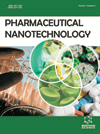- Home
- A-Z Publications
- Pharmaceutical Nanotechnology
- Previous Issues
- Volume 2, Issue 4, 2014
Pharmaceutical Nanotechnology - Volume 2, Issue 4, 2014
Volume 2, Issue 4, 2014
-
-
Anti-Cancer Efficacy of Intravenously Administered Tumor- Targeted Vesicles Entrapping Tocotrienol
More LessAuthors: Ju Yen Fu and Christine DufesDespite its potent in vitro anti-cancer activity, the vitamin E extract tocotrienol has its therapeutic potential hampered by its poor bioavailability and by its inability to reach tumors in a specific way after intravenous administration. One possibility to overcome this issue would be to entrap tocotrienol within vesicles bearing transferrin, whose receptors are present in abundance on many cancer cell types. In this study, we d Read More
-
-
-
Star Shaped Poly(ethylene glycols) Yield Biocompatible Gene Delivery Systems
More LessAuthors: Jayanant Iemsam-Arng, Xiao Kong, Andreas G. Schatzlein and Ijeoma F. UchegbuCationic gene delivery molecules are relatively cytotoxic [50% cell survival concentrations (IC50) < 0.05 mg mL-1], limiting their use clinically. We hypothesise that a low molecular weight polymer with reduced amine content would yield biocompatible gene therapy nanoparticles with DNA. We synthesised and characterised an amine terminated poly(ethylene glycol) – (PEG) based polymer - tetra-O,O,O,O-[poly(ethyleneglycol-O- Read More
-
-
-
Ligands with Delocalized Charge Density and Hydrophobicity Significantly Affect the Transfection Efficacy of the PAMAM Dendrimer
More LessAuthors: Santosh Yadav, Ayushi Priyam, Manohar Mahato, Smriti R. Deka and Ashwani K. SharmaPolyamidoamine dendrimers (PAMAM) are being used as efficient vectors for delivery of nucleic acids to the cells. However, these dendrimers cause a significant amount of cytotoxicity. In order to improve its transfection efficiency and cell viability, surface amine groups of PAMAM were converted into guanidinium (Gn) and tetramethylguanidinium (TMG) moieties. These modified PAMAM dendrimers interacted with negati Read More
-
-
-
Efficacy of Loteprednol Etabonate Drug Delivery System in Suppression of in vitro Retinal Pigment Epithelium Activation
More LessAuthors: Anjali Hirani, Yong W. Lee, Yashwant Pathak and Vijaykumar SutariyaChoroidal neovascularization (CNV) is the growth of abnormal blood vessels in the choroid layer of the eye; it is a pathophysiological characteristic of wet age-related macular degeneration (AMD). Current clinical treatment utilizes frequent intravitreal injections, which can result in retinal detachment and increased ocular pressure. The purpose of the current study is to develop a novel drug delivery system of loteprednol e Read More
-
-
-
Preparation and Characterization of MKT-077 Nanoparticles for Treatment of Alzheimer’s Disease and Other Tauopathies
More LessAuthors: Umesh K. Jinwal, Aditya Grover, Malathi Narayan, Anjali Hirani and Vijaykumar SutariyaAlzheimer’s disease is one of the most common causes of dementia and death in elderly populations. However, therapeutic intervention in Alzheimer’s disease is limited by the blood-brain barrier, which not only protects the brain by limiting the permeation of potential toxins into neural tissue but also by blocking certain drugs aimed at neurological disorders. MKT-077 is one such drug, which has shown promise in reducin Read More
-
-
-
Preparation of 18β-glycyrrhetinic Acid Nano-Rods Using Emulsion- Solvent Evaporation Technique for Application in Cosmetics and Pharmaceuticals
More LessAuthors: Makhmur Ahmad, Washim Khan and Bibhu P. PandaSolid lipid nanoparticles of a lipophilic cosmeceutical molecule, 18β- glycyrrhetinic acid were prepared by emulsion-solvent evaporation technique, using methanol as solvent, stearic acid as lipid and tween 80 as surfactant. The solid lipid nanoparticle preparation was optimized by response surface methodology using Box Behnken design. Under optimum level of stearic acid (0.68%), tween 80 (0.5%) and 18β-glycyrrhetinic a Read More
-
Most Read This Month
Article
content/journals/pnt
Journal
10
5
false
en


